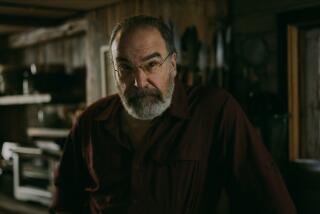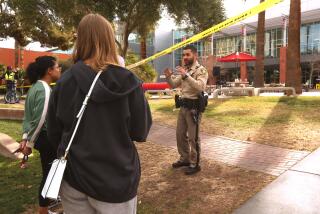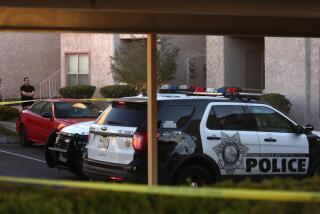Pitino, Kentucky Do a Lot for Each Other
- Share via
LEXINGTON, Ky. — The van slowed to an uncertain stop at a red light outside Somerset, Ky., bringing forth only timid mumbles from its driver, Kentucky basketball manager Jeff Morrow, and his able shotgun man, Bill Keightley. Rick Pitino sat in the back, and while he can get you nicely from midtown Manhattan to Oyster Bay, at this moment he might as well have been on Mars without a map.
Ninety minutes earlier, the van had been pointed south from Lexington on state Route 27, a sublime succession of rolling hills and long white fences that slips gently through the likes of Bryantsville, Halls Gap and Waynesburg. The sun had set to the right of traffic, leaving a purplish-pink sky as the backdrop to this trek into the hinterlands, where Pitino would scout a high-school player in his native environs, measuring his worthiness to someday play for the beloved Wildcats.
But these were ancillary matters, for this group was clearly lost. Keightley jumped from his seat, chugged forward to a police car and stuck his head in the window to advise the officers of both the van’s chief passenger and its destination.
Keightley returned just as the police car set its lights flashing and its siren wailing. “The cop said, ‘Where is Mr. Rick Pitino?”’ Keightley cackled. And within minutes, via police escort, the van pulled into the back lot of Somerset High School, right behind the Russell County High bus. Pitino’s party was hustled past the ticket table and into a front-row seat on the stage in the home of the Somerset Briar Jumpers. The “Briar Patch,” of course. A chant went up instantly.
A line formed to Pitino’s left, small children clutching torn pieces of mimeographed game programs, requesting autographs. Pitino signed with patience and charm.
They say in Kentucky that the two most important people in the state are the UK basketball coach and the governor. In that order. Games are broadcast on nearly 100 radio stations. “There are people in the state,” said Kentucky Athletic Director C.M. Newton, a UK grad himself, “who have never set foot on this campus, yet who listen to every game and live and die with this program.” They have a 24,000-seat arena with a waiting list 6,000 names deep and two weekly newspapers devoted entirely to Kentucky basketball. This is, lest we forget, the home of Adolph Rupp.
“It’s enormous,” said Cawood Ledford, for 38 years the Kentucky play-by-play man. “Unless you come here, you can’t understand it. It may be important, really. In fact, I know it is.”
Joanne Pitino, Rick’s wife, was thrown into the middle of this frenzy two years ago, and she is still reeling from the effect. “You’ve heard the expression ‘live and breathe’ for something,” she said. “I always thought it was just a saying. It’s not.”
It was only two winters ago that both Pitino and Kentucky (the team, the players, the state ... pick one) were under siege. Pitino was in the process of coaching the New York Knicks to 52 victories and the Atlantic Division title, yet feeling unappreciated and increasingly uncomfortable with each passing day. Kentucky was sitting beneath the formidable sword of the NCAA, which in the spring of 1989 would bring down a series of heavy sanctions, including a reduction in scholarships, a year without television and two years without postseason play. Enough, in short, to bury a proud program in shame. That they should find each other is only one of those perfect matches that just never happens in real life.
Already Kentucky is back, with a 17-1 record and leading the SEC (9-1), even if it can’t play for the title again until next season. More quickly than anyone expected, too, and all because of Pitino. So what’s a few autographs?
“For a person like myself,” Pitino said, “a place like this is heaven.”
The conventional wisdom is that Pitino spent two years in New York, couldn’t stomach his malevolent relationship with Al Bianchi, got chewed up by the intensity of the media, lost the respect of players who grew tired of his rah-rah approach and went sniveling back to college ball, chastened for his aspirations. In this there is a little truth.
Such as: He dislikes Bianchi and couldn’t get far enough away from him quickly enough. “I didn’t like his methods, and I don’t care for him,” Pitino said.
The rest of it hangs squarely on your measure of success and failure and also on what has since become of the Knicks. Pitino took a team with 24 victories, won 38 his first season and 52 the next, 1988-89. The Knicks, seeded No. 2 in the Eastern Conference playoffs, struggled to sweep the seventh-seeded Sixers in the first round of the playoffs and were eliminated by the sixth-seeded Bulls in six games. In short order, Pitino was gone, leaving behind a wake of criticism that had built through the winter: that he couldn’t coach emotionally through an 82-game season, that his fullcourt system wouldn’t work in the NBA ... and it is still an open wound.
“Here we were, winning, and everybody lost sight of the important things,” Pitino said. “The Garden was rocking, people were having fun, and we were scoring 118 points a game. The team was a family. It’s nonsense that they were tired of the rah-rah stuff. We had a rule: You play every game as if it’s your last game.
“I’ve heard people say, ‘His system didn’t work, so he went back to college,”’ Pitino said. “That’s garbage. I knew the halfcourt game. I worked with Hubie Brown, whom I admired very much. When you’ve got Truck Robinson, Ernie Grunfeld, Bill Cartwright and Bernard King, you have to play that way. I had Newman, Jackson and Wilkins. I had to camouflage weaknesses. I knew what I had. We were in great shape. Mark Jackson was at the top of his game, Wilkins was playing great, Oakley was rebounding and Ewing was playing outstanding basketball. He may be better statistically now, but they’re not winning.”
Someday, maybe another shot. NBA general managers will call, this you can count on, and people will draw some shaky parallel between Pitino and Lou Holtz, men with something left to prove. He even muses occasionally. “Not that I’m going back to the NBA,” he said, “but I wonder what it would be like to get five guys who could score and pass and make them work on defense ...” But not now. The Knicks experience taught him a lesson that he holds tightly.
In the afternoon following the news conference announcing Pitino’s hiring in the spring of 1989, he gathered what was left of his team at Memorial Coliseum. LeRon Ellis was gone, Chris Mills was gone, Sean Kemp and Eric Manuel wouldn’t be coming. What was left was a roomful of role players, unlikely building blocks to a future of any consequence. Pitino told them otherwise.
“He left us that day with confidence,” said point guard Sean Woods, then a freshman. “His attitude was very positive. He told us it was going to be a lot of fun. I was thinking, ‘Hey, this guy might be somebody we really need.”’
Last winter, in Pitino’s first season, Kentucky went 14-14 with a team that had no right playing in the SEC. True to Pitino’s word, the pace was dizzying; Kentucky set seven NCAA records for three-point shooting, including 810 attempts for the season and 53 in a single game. The results were diverse, running the gamut from a 150-95 loss to Kansas to a 100-95 upset of LSU. “And I think the people enjoyed being the underdog for a change,” Ledford said.
Imagine what might happen with talent involved. Pitino last year recruited 6-8 Jamal Mashburn out of Cardinal Hayes in the Bronx and this year has signed 6-9 Andre Riddick of Bishop Loughlin, regarded by some as the best player in New York City.
He was given a seven-year contract (and reportedly makes more than $1 million, with all perks), ostensibly because Newton believed it would take that long to resurrect the program. Pitino predicted 16 wins for this season and by Jan. 19 they had 15. They are ineligible for the SEC title, but both Newton and Pitino have vowed to hang a banner if Kentucky has the best regular-season record. As for the NCAA Tournament, that is a greater lament. With all the wisdom of a 19-year-old freshman, Mashburn said, “No question, we could have done some damage.”
More to Read
Go beyond the scoreboard
Get the latest on L.A.'s teams in the daily Sports Report newsletter.
You may occasionally receive promotional content from the Los Angeles Times.










